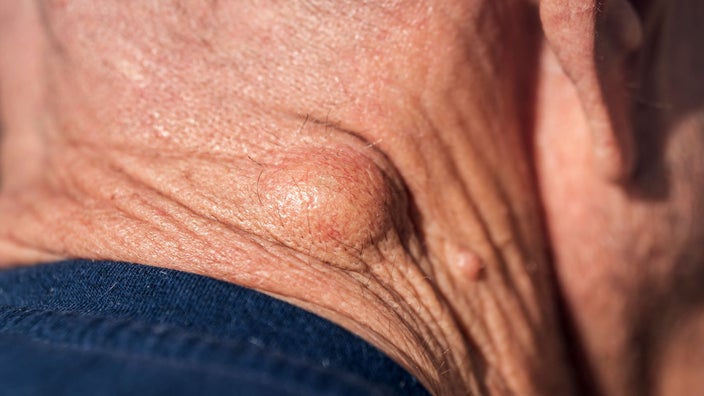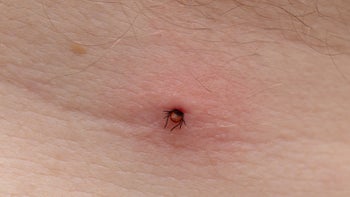
Lipomas: Photos, Symptoms, Causes, and Treatments
Key takeaways:
Lipomas are a common type of tumor that’s caused by an overgrowth of fat cells. They are benign (noncancerous) and usually don’t need treatment.
Lipomas most often appear as soft, painless lumps under the skin. It’s common to find them on your trunk, arms, or legs.
In some cases, lipomas are treated with nonsurgical and surgical methods. How a lipoma is treated may depend on the size and location of the tumor.
Table of contents

Lipomas are the most common soft tissue tumors in adults. Even though the word “tumor” sounds scary, lipomas are almost always harmless. They’re benign tumors, which means that they’re not cancerous and don’t spread to other parts of the body.
What is a lipoma?
Lipomas are made of a collection of fat cells that clump together under the skin. If you don’t like the way a lipoma looks or if it’s causing discomfort, you can usually have it removed. Rarely are lipomas of serious concern. If there’s cause for concern, surgery may be required to prevent complications.
What causes a lipoma?
It’s unclear what causes most lipomas. They sometimes happen in areas where trauma has occurred and led to inflammation in the damaged tissue. Inflammation triggers the release of chemical signals to help with healing. Some of the chemical signals that help with tissue repair may cause fat cells to grow unconstrained. These cells may grow faster and in different patterns (lumps) than other fat cells and cause a lipoma.
In some cases, there may also be a genetic factor. Familial multiple lipomatosis (FML) is a rare syndrome that can lead to lipoma formation. People with FML usually have multiple, painless lipomas on their trunk and limbs. This syndrome is sometimes passed directly from parent to child.
Risk factors for developing lipomas
Some other factors that can increase the risk of lipomas are:
Diabetes
High triglyceride levels
Heavier body weight
Drinking too much alcohol
Search and compare options
What do lipomas look like?
Lipomas usually look like a small lump or swelling under the skin. Most lipomas are solitary, which means there’s only one on the entire body. It’s possible, however, for people to have two or more lipomas at one time.
Lipomas are generally skin-colored, soft, and can feel rubbery or squishy to the touch. Their sizes vary widely, but they are most often 2 cm or less in size. Giant lipomas are growths that reach over 5 cm.
Lipoma photos
Here are some pictures of lipomas in different skin tones.




What are the symptoms of a lipoma?
Lipomas under the skin rarely cause any symptoms. The only symptom most people notice is a soft lump under the skin. Lipomas are usually painless and grow very slowly.
Depending on its size and where it’s located, a lipoma can cause other symptoms. Rarely, a lipoma can become very large or be in a more worrisome location like the gut, lungs, or liver. In these instances, a lipoma may cause pain or interfere with the function of the organ.
How do you diagnose a lipoma?
The best way to diagnose a lipoma under the skin is a physical exam. A healthcare professional can likely examine the lump to see if it has features of a lipoma or if it’s more likely another type of growth (like a cyst).
Sometimes, additional testing is needed to confirm the diagnosis. This may be the case if the growth is:
Very large (greater than 4 inches)
Fast-growing
Painful
Firm
In an unusual location
Below are some of the tests used to help diagnose a lipoma.
Skin bumps that aren’t acne: From milia to cysts, learn how to identify the most common skin bumps that aren’t acne (with images).
All about sebaceous cysts: Read about what causes these common skin bumps and how you can treat them.
Could it be skin cancer? See what different types of skin cancer look like on different skin tones (with pictures).
Biopsy
If it’s unclear if a mass is a lipoma after a physical exam, a healthcare professional may want to get a tissue diagnosis. These are usually minor procedures done in the office. Types of biopsies include:
Excisional biopsy: For this kind of biopsy, a healthcare professional will remove the entire mass. The size and location of the tumor will determine how involved the surgical procedure needs to be.
Fine needle aspiration biopsy (FNA): This kind of biopsy is done with local anesthesia and a small needle. In this procedure, the healthcare professional will suction a small amount of the tumor through the needle.
With either method, a pathologist then examines the tissue to look for fat cells and confirm that the mass is a lipoma.
Read more like this
Explore these related articles, suggested for readers like you.
X-rays
X-rays are simple and inexpensive tests that can help a healthcare professional decide if a tumor is a benign lipoma or a more concerning mass. If a diagnosis is uncertain, an X-ray may help to confirm that the mass is a lipoma or prompt them to order other tests.
Ultrasound
An ultrasound uses radio waves to examine soft tissue. Lipomas have a characteristic appearance on ultrasound. However, other tests may be needed to confirm that a mass is a lipoma.
CT scan
CT scans can look at the deep tissues of the body. If a lipoma is in a spot that’s hard to examine, a CT scan may be a good diagnostic option. And a CT scan is faster and less expensive than an MRI.
MRI
An MRI makes very detailed pictures of the soft tissues. An MRI scan can help differentiate between a lipoma and another type of tumor. If another type of tumor is suspected, a biopsy may be necessary.
How do you treat a lipoma?
The vast majority of lipomas don’t need treatment at all. The most likely reason you might seek treatment for a lipoma is because of the way it looks. This may be especially true for lumps on the face, head, and neck.
You might also consult a healthcare professional about a lipoma if it’s causing pain. If your lipoma is causing symptoms or cosmetic concerns, here are some common treatment options that are available.
Steroid injections
Lipomas are sometimes treated by injecting a mixture of a local anesthesia (like lidocaine) and steroid (like triamcinolone). This is best done on small tumors and may need to be repeated several times. The steroid medication helps the tumor to shrink over time.
Liposuction
Liposuction can work for small or large lipomas, especially in areas where you’d want to avoid a scar. After numbing the area, a healthcare professional will use a needle and syringe to suction out the fat. Lipomas may regrow with this method, since liposuction can’t remove all of the fat cells completely.
Enucleation
This procedure scrapes the fat cells out of the lipoma through a small incision. Stitches are usually not necessary with this method. But, if the entire lipoma isn’t removed, it may grow back.
Excision
Surgical removal may be the best option if the lipoma is large or if you want the best chance of avoiding recurrence. This can be done in a clinic or a surgery center, depending on the size and location of the lesion. It removes the entire tumor, which means it shouldn’t grow back.
What other conditions look like lipomas?
There are other conditions that share similar symptoms with lipomas. Treatment options differ based on the condition, so it’s important to get the right diagnosis. Here are some conditions that may mimic lipomas.
Cysts
There are different types of cysts that can look like lipomas (like sebaceous cysts). Cysts are fluid-filled and may have a tiny opening in the center of the lump.
Cysts don’t need to be treated unless they become uncomfortable, infected, or cause cosmetic concerns. Treatments include:
Drainage
Surgical removal
Steroid injections
Antibiotics
Dercum’s disease
Dercum’s disease is rare and happens more often in postmenopausal women. It causes multiple lipomas to form in the skin, usually on the torso, and upper arms and legs. Unlike an ordinary lipoma, the lipomas in Dercum’s disease are usually painful.
The cause of the condition is unknown. Unlike with lipomas, people with Dercum’s disease frequently have other symptoms. These include:
Fatigue (feeling tired)
Swelling of the limbs or hands
Brain fog
Weight gain
Treatment is usually focused on pain control and removal of the growths through liposuction. Surgical removal may lead to inflammation and excess tumor growth.
Liposarcoma
Liposarcoma is a rare type of cancer that can look like a lipoma. It doesn’t usually spread to other parts of the body. But it can grow to a large size and press on the tissues next to it.
Liposarcoma usually affects the limbs, but it can happen in other places. Its symptoms depend on the size, location, and effect on normal body function. Imaging studies or a biopsy can be helpful in making the diagnosis.
Surgical removal is the only treatment, but it may grow back.
What are the complications of an untreated lipoma?
It’s OK to leave a simple lipoma under the skin untreated. It may become bigger over time, but even large lipomas don’t usually cause symptoms. If you’re worried about the appearance or the lipoma is interfering with your normal activities, you should talk with a healthcare professional. They can help determine the best treatment plan for you.
Frequently asked questions
Lipomas are noncancerous growths and they don’t usually turn into cancer. In very rare situations, a lipoma can turn into a cancerous fatty tumor called a liposarcoma. Let a healthcare professional know if you notice any of the signs below:
The lesion is growing very rapidly.
You notice a change in texture (like from soft to firm).
You suddenly develop symptoms (like pain).
If worrisome signs develop, a biopsy can help determine if cancer is present.
Lipomas don’t usually go away on their own. They tend to either stay the same size or grow slowly over time.
So far, there’s no proven way to shrink a lipoma through natural remedies. The best way to get rid of a lipoma for good is through surgery or other procedure.
The bottom line
Lipomas are fatty tumors that can develop almost anywhere on the body. Although most times they aren’t worrisome, there are times that you may want to have your lipoma treated. This may be true if you feel it’s unsightly or it’s causing symptoms.
Treatments can vary and may depend on the size and location of your lipoma. Talk with a healthcare professional to discuss your options.
Why trust our experts?



Images used with permission from VisualDx (www.visualdx.com).
References
Al-Housni, O., et al. (2024). Dercum’s Disease: The clinical presentation, diagnosis, radiological findings, and treatment of a rare, debilitating inflammatory disorder. HCA Healthcare Journal of Medicine.
Allen, B., et al. (2007). Giant lipomas of the upper extremity. The Canadian Journal of Plastic Surgery.
American Family Physician. (2002). What are lipomas?
Burt, A. M., et al. (2017). Imaging review of lipomatous musculoskeletal lesions. SICOT-J.
Callan, A. K., et al. (2023). Lipoma. OrthoInfo.
Charifa, A., et al. (2022). Lipoma pathology. StatPearls.
Genetic and Rare Diseases Information Center. (2021). Familial multiple lipomatosis. National Institute of Health.
Glazier, E. M., et al. (2022). Lipomas are benign masses caused by overgrowth of fat cells. UCLA Health.
Higgins, J. C., et al. (2015). Diagnosing common benign skin tumors. American Family Physician.
Kolb, L., et al. (2023). Lipoma. StatPearls.
National Organization for Rare Disorders. (2020). Dercum’s disease.
Parkash, A., et al. (2024). Study on the correlation between hyperlipidemia and lipoma. International Journal of Pharmaceutical and Clinical Research.
Peev, I., et al. (2017). Liposuction assisted lipoma removal – option or alternative? Open Access Macedonian Journal of Medical Sciences.
Salam, G. A., et al. (2002). Lipoma excision. American Family Physician.
Sigmon, D. F., et al. (2022). Fine needle aspiration. StatPearls.
Zafar, R., et al. (2023). Liposarcoma. StatPearls.





























